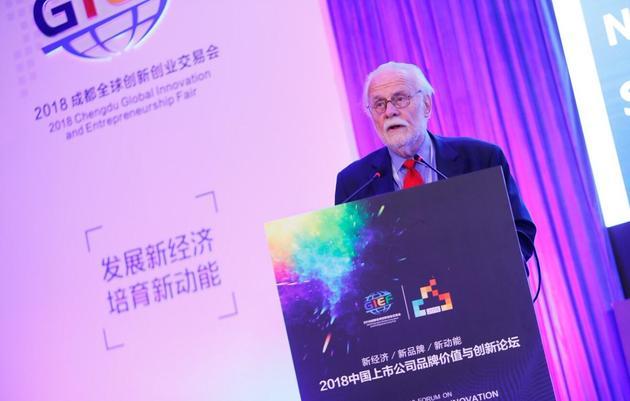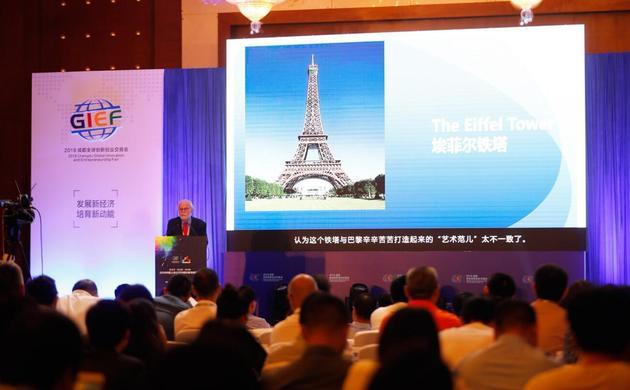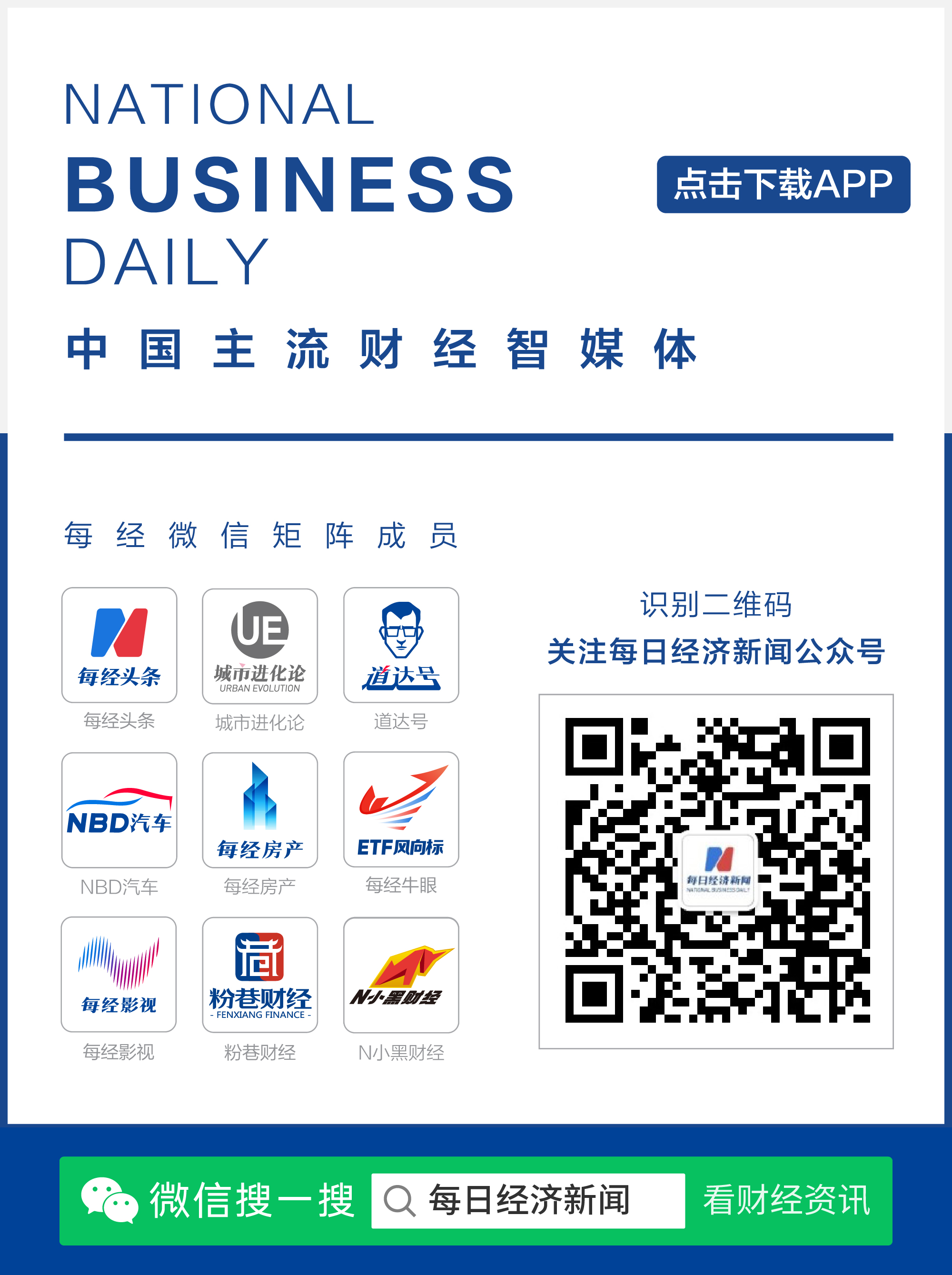每经记者|官远星 每经实习记者|黄名扬 每经编辑|宋思艰
“从奔驰、迪奥,到苹果、李维斯……大企业几乎从来不吝啬,花费相当大的努力和成本去培养自身的品牌价值。” 全球城市竞争力项目主席、经济学家、美国巴克内尔大学经济系教授彼得·卡尔·克罗索如此表示。
今日(5月19日)下午,2018中国上市公司品牌价值与创新论坛在成都举行。
本届上市公司品牌价值与创新论坛,“智囊团”阵容华丽升级。作为“升级版智囊团”成员之一,克罗索教授在论坛现场发表了题《品牌与城市竞争力的互助共生》的演讲,从学术角度分享品牌与城市的共生关系,为企业和城市培育品牌价值提供了新颖视角。
 全球城市竞争力项目主席、经济学家彼得•卡尔•克罗索(Peter Karl Kresl)(每经记者 张建/摄)
全球城市竞争力项目主席、经济学家彼得•卡尔•克罗索(Peter Karl Kresl)(每经记者 张建/摄)
全球经济转型换挡,品质之外,品牌竞争已成为制胜关键。而在克罗索教授看来,城市品牌的建立同样重要,并与该地的企业品牌互生共赢。
事实上,克罗索教授一直致力于研究品牌价值在城市层面的实践与应用,并长期关注中国城市发展。他曾在联合国人居署、经合组织等多次发表文章,并与中国学者共同撰写《全球城市竞争力报告》等。
他认为,塑造城市品牌,就是为了让一座城市的形象印在消费者、游客、企业,包括市民和城市管理者们的脑海里。“比如,芝加哥被称作”风城“、巴黎又叫‘光明之城’、罗马别称是‘不朽之城’、纽约被称为‘大苹果’、旧金山是‘海湾之城’”。
他总结这类城市品牌的打造,都是紧紧抓住自身某个“众所周知”的特点。“这种城市名片有利于城市品牌的快速传播,却无法展现当地企业的品牌特征”。
“如巴黎修建埃菲尔铁塔,向世界宣布法国成功地建造了这个复杂的工业钢结构。以此传递其工程、冶金、制造业、钢铁建筑等现代工业的发达形象。”克罗索教授赞叹道,以这种方式宣传自己的巴黎,成功为该城市甚至整个法国的汽车、轮船、火车等制造企业,树立了同样积极的品牌形象,确立了相关行业的企业在国际上的较高地位。
由此可见,明确且有产业指向的城市品牌,能够反向使企业品牌随之获益。
然而,他也坦言,要准确传递出城市的品牌形象,对城市管理者们来说并不是一件容易的事。“比如英国一直很想打造一个潮流、创新、创意的国家形象,但遗憾的是,他们的宣传推广却总是把自身往骑士、乡村和辉煌的历史上靠。”
因此,在他看来,明确城市品牌的定位非常重要。但作为城市的主体构成,市民和企业家更应积极献言献策。
“城市品牌塑造是一个严肃的命题,对于城市本身与生存在城市中的企业来说都是至关重要的。”克罗索教授建议到,如果在城市品牌塑造的问题上,一味地聘请第三方“专家”,可能造成打造出来的城市品牌与地区本身的历史、人文特点相违背的后果。“我们应该更聚焦市民,毕竟他们才是最懂这片土地的人,而这个城市最终的发展目标也要依靠他们去实现。”
“濯锦江边两岸花,春风吹浪正淘沙”,成都这座历史名城早就吸引到了外国友人的目光。
“2006年,我第一次就来过成都。” 在谈到成都城市品牌时,克罗索教授肯定了这座锦绣城市多年来努力的成果。“对成都而言,如今城市品牌的崛起,绝非一朝一夕之功,而是长期积累的结果。”
他回忆道,那时他就获知摩托罗拉在成都有厂区,因特尔也即将在此建成新厂区。另外,这里还有数所科技型高校、100多家小型科技初创企业。同时,劳动力的受教育程度也相对较高。“显而易见,那时的成都正站在通往成为一个‘科研技术’城市的道路上。这是成都一直以来想要向外界传递的城市形象。”
《每日经济新闻》记者注意到,除了肯定,克罗索教授也诚恳地对成都的城市品牌建设阐述了他的思考。
他首先强调,成都是一座适合旅游和居住的城市,“从大熊猫到金沙遗址,从变脸到川菜美食,从悠闲自得的民众心态到休闲之都宜居城市……成都不是一座古老、衰退、污染严重的工业城市。”他认为,成都应该继续发挥自己的优势。
此外,克罗索教授提到,成都有许多技术与工程、石油、信息技术和科技类高校。在他看来,作为高科技和研发城市,在成都不应刻意强调电子装配等低技术业务,而应突出“高科技”的品牌特征。他类比城市品牌塑造极其成功的硅谷城市群说道,“就像硅谷,从一开始他所象征的就是高科技研发,生产组装环节就是被排除在外的。”
事实上,很多城市在塑造自身品牌时,都难免“走岔路”。
基于此,他再三强调,一定要让他人根据城市已取得的成就来作判断。“”查尔斯·兰德利是以想像力和创意推动城市改造的国际权威,他认为,如果一个城市想要打造‘创意城市’的形象,那么它绝不能自称“创意城市”,你可以采取行动,比如说,开展研究、帮助新公司申请专利、举办高级研讨会和会议等等,这些活动会让自然地人们认识到,这是一个学习、生活和工作等各方面都有创意的城市。“
“关键的是,要顺其自然。”克罗索教授总结道。
附演讲全文(英文):
The Correlation of Branding and Urban Competitiveness
When I told my friends that I was going to spend a week in Chengdu at a very interesting conference, invariably the response was "Oh, will you get to see the pandas?" This is what Chengdu is to the average person who lives in the rest of the world, if they know Chengdu at all. Is this adequate for the people who work in Chengdu and who are proud of their city - isn't Chengdu more than pandas, important and cute as they are? Paris is more than croissants; Chicago is more that the stockyards, Tokyo is more than cherry trees - so what of Chengdu.
This gets us to the practice of branding. Companies spend considerable effort to brand themselves - Mercedes Benz, Christian Dior, Levi's jeans, Apple and other firms all have carefully developed and managed brand identities. The brand gives them a certain place in the market and the image of quality or affordability or durability in the mind of the consumer.
But we can see how this can go wrong when a company such as Volkswagen does something that damages the image, such as cheating on diesel emission tests, or when a major bank, such as Wells Fargo or HSBC, is found to have laundered funds from illegal activities or deceived its customers. In these instances the brand now conveys deception or illegality or some other unacceptable activity. A successful brand has to be developed, nurtured and maintained scrupulously.
Most of you are specialists in business enterprises, and you all have some understanding of how important a company's brand is to its long-term vitality. I doubt there is much I could tell you about corporate branding that you do not already know. My special interest is in cities and in their competitiveness in a competitive world, that of the struggle for economic activities, corporate locations, talented and skilled workers, and reputation in a world of aggressive cities all interested in obtaining the same things. Nonetheless there is a strong linkage between the brand of a city and the possible branding of the companies that operate within its boundaries. So how is a city to succeed in this global competitive struggle and how can it work to benefit its local business enterprises?
One example from recent history will illustrate effectively how this can be done. In 1871 France lost the Franco-Prussian War and was humiliated into ceding to Prussia two of its provinces, Alsace and Lorraine, and the city of Strasbourg. France was known as a country that specialized in agriculture that was renowned for its famous wines and cheeses, for oysters and seafood, as well as for art, music and culture in general. Britain was known for ship building, bridge building and steam locomotives, while Prussia was renowned for manufacturing, heavy industry, and war material. What could France do to alter its international image, and perhaps even its self-perception? The solution was to build the Eiffel Tower! French engineer Gustav Eiffel proposed the tower, for the World's Fair in 1889 as a symbol of this alternate image of France. In retrospect we can see the Tower as a graceful and impressive structure, but immediately the Tower was attacked by artists, musicians, sculptors and architects who, of course, saw it as an affront to the image of France they had so carefully developed over centuries. The beauty they had worked to create was insulted by what they saw as the Tower's ugliness.
In reality the Tower served no practical purpose, in that it housed neither offices
nor apartments, nor was it particularly beautiful, as things in France naturally should be. But what the Tower did was declare to the world that France, having successfully constructed this complex structure of industrial steel, was a nation of engineering, of metallurgy, of manufacturing, of steel construction, and, indeed, of modern industry. France, having branded itself in this way, gave legitimacy for its manufacturing firms to brand themselves similarly and to hold their heads high internationally. They too could be a nation of automobiles, of ships and trains, of factories and of advanced manufacturing - and ultimately of the TGV! In 1964, the Tower was actually given historical landmark status. This successful exercise in 'city branding' has given inspiration to hundreds of other cities to undertake branding exercises, exercises that have similar positive impacts on the firms that are identified with that city.
A quite different experience with branding took place in what has become known as Silicon Valley. Here there is no single metropolitan area or city, but rather a set of several cities in the Santa Clara Valley - San Jose, Palo Alto, Sunnyvale, Cupertino and Mountain View. In 1957 after Sputnik, President Eisenhower turned to Fairchild Semiconductor to make transistors for the space program. After this Hewlett-Packard, Stanford University, and many other companies developed. William Shockley, the inventor of the transistor moved to Palo Alto to care for his ailing mother and had an impact on the activity of these firms for many years. No municipal authority came up with the term Silicon Valley; rather it was first used in a local newspaper in 1971. Hence the term was developed to describe what the firms in the area were actually doing - using silicon for manufacture of semiconductors for use in solid-state devices in computers and micro-electronics. This led to very sophisticated research to create new products and, of course, new firms. In a sense this was a bottom-up process, from firms to the city or region than the typical top-down, from the city to the firms. From the beginning there was no reference to anything but high technology research and development - assembly of products was to be done elsewhere.
In the case of the Eiffel Tower, we have a government designing a project that would have an inspirational impact on the nation's industrial firms, whereas in Silicon Valley, business firms and entrepreneurs engaged in activity to which outsiders gave a descriptive term. Similar to this would be the industrial district in Germany, the Ruhr - no advertising agency for city official designed this designator, it just evolved out of the industrial work that was done by the firms located there, and the term came into use locally in the mid-19th century and internationally in the years following the First World War. It is clear that the companies in these regions all benefitted from location in Silicon Valley or the Ruhr, in that it gave them an identity that was very positive, it linked them with other very successful companies, and made it easier to attract desirable skilled workers. The brand of the company was tightly linked with the brand of the region.
An example that runs counter to this is that of the Research Triangle Park, in the state of North Carolina in the US. This is a research center that was the idea of a couple of individuals who saw North Carolina as a somewhat backward state, but that had three universities in close proximity to each other: Duke University, the University of North Carolina and North Carolina State University. They took the idea of a research center situated in the midst of these three research universities to Governor, and after much discussion the idea was approved in 1955. A year later there was a new President of the University of North Carolina who supported strongly the Research Triangle Center idea. It took another decade before the idea was realized when IBM located a large research facility there. It soon grew to become perhaps the most successful research park in the US. It now has over 200 companies and 50,000 workers, all in research. The Center is owned and operated by a private Research Triangle Foundation. Hence, it offers yet another model of how to develop a brand, that of "collective entrepreneurship". In this instance the idea and the actual brand existed before there were any structures or activity in the area and it was realized by individuals in the private, university and government sectors. - a purely top-down approach to branding.
On the other hand, the identity or brand of a region or city that is in decline also extends to the identity or brand of most of its component companies. In declining regions or cities of the US, such as those in the old rust belt the malaise extends to firms that are based there. They all decline together as they cannot establish a linkage with one or more firms in stronger and/or rising region or city. The same may be true for cities in the North-East of China. The best option for these firms is often to relocate to another region and to work to re-brand themselves in a more positive image.
The difficulty those in charge of a city or country have in publicizing their message about the local brand, is clearly shown when Britain was trying to project the image of a country that was cool, creative and innovative, a survey of promotional literature from scores of British towns promoted images of knights in armour, country peasants and the glorious past. Where were the visional leaders and the risk-takers? What were those who design company brands to do? Go with the solid past or with the possible future? Was it all irrelevant to them so that their branding was utterly up to them with no assistance from government, national or local?
City and company branding
The purpose of branding for a city is to create an image of the city in the minds of consumers, tourists, businesses, other cities, and, of course, of its own residents and of the city administration itself. Some of the brands capture some recognized aspect of the city such as Chicago the Windy City, Paris the City of Light, Rome the Eternal City, New York the Big Apple, and San Francisco the City by the Bay. They are a short-hand way of capturing some identifier that conveys meaning to the user, but they need not convey anything that captures the economic activity of the firms located there and that they can build on for their own image or brand. Some are aspirational in that they seek to elevate the character and status of the city: Atlanta the Athens of the South, Boston the Athens of America, Edinburgh the Athens of the North (of Britain) are all examples. Others are humorous: Gallup (New Mexico, US) Drunk Driving Capital of the World or Cape Hatteras (North Carolina, US) Graveyard of the Atlantic, in recognition of the vast number of ships on the bottom of the sea nearby. The imagination seems to be unlimited here.
However, there is a more serious side to city branding and how it relates to the branding done by the cities and the companies that are part of that urban economy. One danger is that inviting outside professionals to manage the place branding exercise may open the city officials to charges that they are ignoring, or distorting parts of the place's character, history or even population. Local residents must be central to the initiative, since the aspirations they seek to realize are best understood by themselves and must be integral to the lives they live and wish to live. Outsiders often adopt with little accommodation to the local situation an existing strategic plan for branding and marketing that they have developed for another situation. As the architect Eero Saarinen stated, "Only little can be accomplished in civic improvement, unless the people of towns and cities themselves, individually and collectively contribute their positive support". These words are often not followed, and it has been estimated that 86 per cent of city branding initiative fail within the first year. One of the leading consultants in this area has stated: "Many consider that branding is purely a function of marketing communications and they do not take into account the behavioral, organizational and community-wide implications that successful place-branding can bring".
What of Chengdu?
The task of Chengdu in its city branding is somewhat complex. When I was here in 2006 I was told, with some pride, that Motorola had a facility here and that Intel was close to completing its new facility. There were several universities including a university of technology, over one hundred small tech start-ups and a highly educated labor force. Clearly, the city was on a positive path to becoming a major research and technology city. This was the image that city wanted to project. I was very pleased to be asked to speak at this conference so I could see how Chengdu has developed, and in the next several days I will have that opportunity. But when one examines the information about some of the tech centers, one finds them advertising high tech activities, retail and parks, but also dormitories - dormitories for whom? For the 87,000 researchers with advanced degrees, many of whom are from "Ivy League universities" - or assembly workers? High tech firms in Silicon Valley and in Seattle do not mention support of dormitories, rather they celebrate the fact that they support fleets of buses that transport highly paid and highly skilled workers from the corporate research facility to desirable living areas in San Francisco or downtown Seattle. The image given is quite positive about the desirability of the company as a place to work and about the high level of the research work that is done in these facilities.
A cautionary note. Charles Landry, has argued that a city that is trying to become a 'creative city' should never refer to itself as a 'creative city' - "let others do that by respecting what you have achieved". Do things, conducting research, helping new firms to file for patents, holding high-level seminars and conferences, and so forth, that will give the image to others that Chengdu is a creative place to study, live and work. Do not force it. St. Louis constructed its Eero Saarinen Gateway Arch, and they then declared St. Louis was the "Gateway to the West" - one New York poet responded that it was perhaps better seen as the "Exit from of the East"! A city cannot always control the use of its brand.
Chengdu will have to be very skilled in shaping the image of the city that the outside world creates for itself. In doing this it might be of value to stress the following:
- Chengdu is not an old, declining, contaminated industrial city,
- Chengdu has many aspects that make it an attractive place for tourism and for living, from the Panda Research Center, to Sichuan cooking, to a city with many urban amenities such as parks and recreation facilities, close to many attractions, and so forth,
- Chengdu is a city of higher education with universities specializing in music and art, in teaching, in sport, and, of course, in technology and engineering, petroleum, science, finance and economics, information technology, and technology,
- As a city of high technology and research, Chengdu should not emphasize electronic assembly and other low skill activities, important as they are for providing employment for lower skilled residents,
- Chengdu is also a well-connected city with direct air linkages with cities in Europe, North America and, of course, throughout Asia, and it is Air China's second hub, after Beijing,
- Chengdu is also attractive due to a lower cost of labor and of living than in China's coastal cities.
Conclusions
I would like to leave you with the following several conclusions about branding:
1)There is a close relationship between a city and its resident companies when it comes to branding. The brand should come out of the activities of the companies.
2)Companies are linked through a common brand with the nature of the competitiveness of the city in which they operate. This way they are most likely to have good relationships with other firms in the city region.
3)There are many successful examples of effective city branding from Paris to Silicon Valley to Seattle to the Research Triangle, and Chengdu could learn from studying some of them. It is most effective when the cities have things in common with Chengdu.
4)Chengdu has great potential to work to establish, in the minds of individuals, companies and cities throughout the world, a brand or an image of the city Chengdu seeks to create. Conferences such as this, but explicitly international in focus and participation are an excellent way to get the rest of the world to become aware of Chengdu and its competitive advantages. This is perhaps the best form of publicity.
Note: This paper relies on work that was done for my book (with Daniele Ietri), Creating Cities/Building Cities, Cheltenham: Edward Elgar Publishers, 2017, esp. ch.
 全球城市竞争力项目主席、经济学家彼得•卡尔•克罗索(Peter Karl Kresl)(每经记者 张建/摄)
全球城市竞争力项目主席、经济学家彼得•卡尔•克罗索(Peter Karl Kresl)(每经记者 张建/摄)
演讲全文(中文译稿):
企业品牌与城市竞争力共生多赢 成都品牌塑造未来可期
来参加“2018成都全球创新创业交易会”之前,朋友们纷纷问我:“那你不就可以去看熊猫了吗?”这大概也是世界上多数人提到成都的第一反应。然而就像巴黎不是只有牛角包、芝加哥不是只有堆场门,东京不是只有樱花,对这座城市满怀自豪的成都人来说,成都也绝不单单只有熊猫,虽然他们确实珍贵又可爱。
这就是品牌的概念了。从奔驰、迪奥,到苹果、李维斯……这些企业总是投入大量的人力物力去塑造和维护自身的品牌形象。品牌则帮助这些企业在消费者心中树立他们的形象,可能是产品质量,也可能是性价比或者耐用性,更重要的是,让他们在市场中有了立足之地。
当品牌形象受到伤害时,事情就没那么好办了。诸如大众“柴油门”,富国银行、汇丰银行涉嫌洗钱、欺骗顾客被曝光等负面事件发生后,都会让这些企业的品牌蒙上“欺骗”或是“违法”的阴影。所以要塑造一个知名品牌,从建立,到培育,再到维护,每一个环节都需要我们谨慎对待。
今天在座的不乏成功的企业家,对品牌之于企业长期可持续发展的重要性一定都有自己的见解,对如何打造品牌、保持品牌活力的体会或许比我还要深刻。我主要研究城市竞争力,就是:一个城市如何在这个充满竞争的时代脱颖而出,在经济发展、招商引资、人才聚集以及城市美誉度等方面突显出自身的独特竞争力,毕竟每个城市都希望在这些方面取得成功。当然,建立城市品牌也离不开在这座城市中发展的企业对自身品牌的打造和推广。那么,对于城市而言,究竟该如何在全球竞争中抢得先机?又该如何运用自身的竞争力去更好地帮助企业的发展呢?
有一个近代比较知名的城市范例:巴黎。1871年,法国在普法战争中战败,还割让了阿尔萨斯-洛林的大部分地区,包括斯特拉斯堡市。当时的法国是个以农业为主国家,最出名的是葡萄酒、奶酪、牡蛎等海鲜,当然还有法国的艺术与音乐。同时期,英国的造船、桥梁、蒸汽机车等技术已经较为先进了,普鲁士又以制造业、重工业以及军火闻名。在这样的国际环境下,法国急切地想要改变世界对自己的印象,在这样的背景下,法国如何改变自己的国际形象以及自我认知呢?那就是重新打造一张“名片”埃菲尔铁塔!
法国建筑师古斯塔夫·埃菲尔提出为1889年巴黎世界博览会建造铁塔,一举改变法国的对外形象。虽然现在我们会觉得埃菲尔铁塔简直是优雅的代名词,但当我们回顾这段往事的时候,其实会了解到当时法国的许多艺术家、音乐家、建筑师都曾反对过建造埃菲尔铁塔,认为这座丑陋的铁塔与巴黎辛辛苦苦打造起来的“艺术范儿”太不一致了。而实际上,埃菲尔铁塔的确没有什么实用价值,又不能用来住,也不能用来办公,而且跟法国自带的“仙气”一比,好像也的确有点配不上。但不可否认的是,埃菲尔铁塔的落成向世界传递了这样一个信息,即法国民族可以建造出这样一座复杂的工业钢结构塔,说明这个国家的工程、冶炼、制造等现代工业已经可以登上世界舞台了。以此为契机,法国制造业的公司也开始在国际市场中崭露头角,在汽车、火车、轮船等领域发力,并最终诞生了TGV(法国高速铁路系统)。在1964年,埃菲尔铁塔也终于被承认为法国巴黎地标。这一典型城市品牌效应给数以百计的城市带来了“灵感”,他们纷纷开始研究城市品牌塑造这一课题,也希望借此给自己城市的地标型企业带来积极影响。
另一个“殊途同归”的例子,就是我们熟知的硅谷。硅谷并不是一个行政意义上的城市,而是由位于圣克拉拉谷中的圣荷西、帕洛阿尔托、森尼维尔、库珀蒂诺和山景城等城市群组成。在1957年前苏联斯普特尼克卫星发射成功后,美国总统艾森豪威尔大力推动仙童半导体公司对晶体管在航空航天领域中的研究。在此之后,惠普、斯坦福大学等机构也在周边开始建立。晶体管之父威廉·肖克利为了照顾自己年迈多病的母亲而搬到帕洛阿尔托(硅谷附近),也促进了硅谷相关企业的发展。“硅谷”这个名字其实不是政府想出来的,而是由当地的一家报纸于1971年首次提出。“硅谷”这个名字也非常形象地描绘出当地企业的主要业务,即利用硅物质来制造半导体以及其他的电子设备硬件。后来,经过不断演变,新的产品、新的公司、新的产业在这片土地上不断崛起。硅谷的诞生是自下而上的过程,从个体企业到城市群再到整个地区。值得一提的是,从一开始,硅谷所象征的就是高科技研发,生产组装环节是被排除在外的。
巴黎埃菲尔铁塔的案例中,我们能看出政府的努力,通过设计这样一个地标建筑有效提振了民族企业的信心。而在硅谷的故事中,是由当地的公司与企业家的经营活动给这个地区打响了名号。和硅谷相似的还有德国的工业基地鲁尔。鲁尔工业区形成于19世纪中叶,并在一战后闻名世界。没有特别的广告宣传或政府引导,鲁尔也是因为当地工业企业而成名。显而易见的是,不管是硅谷还是鲁尔的企业后来都或多或少的受益于自身的区位,因为所在的这个地区就是最好的名片,能够帮助他们与其他成功的公司相连接,也能够帮助他们吸引到最优的人才。从这个角度而言,个体公司的品牌与整个地区的品牌是密不可分的。
最后,我想讲讲位于美国北卡罗来纳州的三角研究园。20世纪50年代末期,北卡州的传统产业发展不佳。北卡罗来纳大学经济学教授奥斯伯特等人大胆提出设想,把北卡罗来纳大学、北卡罗来纳州立大学和杜克大学三所相邻的大学连接起来,利用三点支撑一个三角形平面用来做科学研究基地,把三所大学的人才集中起来,充分发挥他们的聪明才智,利用“地利人和”优势吸引政府、财团、公司、企业来此投资创办研究开发机构。1955年,经北卡州长的同意,建立三角研究园的方案终于得以通过并得到了北卡大学校长的支持。十年后,IBM在此设立大型研究机构,推动了美国三角研究园的快速发展,使其成为了全美乃至于全球最负盛名的高科技研究和开发中心之一。至今为止,占地约320平方公里的园区内,有超过200家研究机构入驻,雇员数量超过5万人。建成后的美国三角研究园由三角研究基金会管理,为我们提供了通过“产业集群”模式打造区域品牌的典型案例。在这个案例中,在三角区地区有实体机构落户、运作之前,有关于三角区的创意甚至是品牌就已经在诸如奥斯伯特教授、北卡大学、州政府层面逐渐形成了,所以这完全是一场“自上而下”的成功策划。
另一方面,如果一个地区或城市的品牌号召力在衰退,势必也会给当地企业带来负面影响。例如,美国的东北部地区,被俗称为“旧锈带”。由于无法与处于上升期的企业或城市建立紧密的合作关系,“旧锈带”整个地区与当地企业的气场都是萎靡不振的。中国的东北老工业区可能也面临相似的问题。那对于当地企业而言,也许最好的办法就是迁址并重塑企业品牌。
要准确传递出城市或国家的品牌形象,对管理者们来说并不是一件容易的事。比如英国一直很想打造一个潮流、创新、创意的国家形象,但他们的宣传推广却总是把自身往骑士、乡村和辉煌的历史上靠。我们不禁要问:英国那些时尚领袖、冒险家去哪里了?那些擅长打造企业品牌的精英要做什么?他们是不是认为在打造品牌这件事上,该坚守传统还是尝试变化只是他们自己的事,而与城市甚至国家完全无关呢?
塑造城市品牌,就是为了让一座城市的形象印在消费者、游客、企业,包括市民和城市管理者们的脑海里。有些城市品牌的打造是紧紧抓住自身某个“众所周知”的特点,比如芝加哥叫“风城”、巴黎叫“光明之城”、罗马的别称是“不朽之城”、纽约被叫做“大苹果”、旧金山是“海湾之城”。这种城市名片有利于城市品牌的快速传播,但无法展现当地企业,因此这些企业的个体品牌形象都更独立。还有一些城市立志于提升城市品质和地位,像亚特兰大的“南方的雅典”、波士顿的“美国的雅典”、爱丁堡的“北方的雅典”。也有的城市比较特立独行,追求幽默效果:新墨西哥州的盖洛普的“世界醉驾之都”、北卡罗来纳州的哈特拉斯角因近海地区沉船太多被戏称为“大西洋的坟墓”。总而言之,想象力是无穷的。
然而,城市品牌塑造更多是一个严肃的命题,其与城市本身以及本地企业的联系都是城市经济发展中的重要环节。如果一味地聘请第三方“专家”,可能造成打造出来的城市品牌与地区本身的历史、人文特点相违背的后果。我们应该更聚焦居民,毕竟他们才是最懂这片土地的人,而这个城市最终的发展目标也要依靠他们去实现。如果那些“专家”在对城市进行全面、深入的调研之前就开始设计这座城市的品牌,那他们只能借鉴过往的经验和案例。20世纪著名的芬兰裔美国建筑师埃罗·沙里宁曾说过:“除非城镇的居民贡献自己的力量,否则城市建设将举步维艰。”可惜的是,这句至理名言践行者少之又少。有数据显示,超过86%的城市品牌营销项目在启动的头一年里就搁浅了。一位业内领先人士指出:我们不应该仅仅把城市品牌塑造当成营销推广的手段,而更应该看重这背后给市民、社区和机构带去的影响。
对成都而言,城市品牌的崛起,绝非一朝一夕之功,而是长期积累的结果。2006年,我第一次来成都,当时有人骄傲地告诉我摩托罗拉在成都有厂区,因特尔也即将在此建成新厂区;成都还有数所科技型高校、100多家小型科技初创企业,同时这里的劳动力受教育程度也相对较高。显而易见,那时的成都正站在通往成为一个“科研技术”城市的道路上。这是成都一直以来想要向外界传递的城市形象。今天,我很荣幸受邀在“2018中国上市公司品牌价值与创新论坛”上发言,并借此机会进一步了解成都迄今的发展情况。如果查阅一些科技中心的相关信息,你会发现它们宣传的除了其高科技业务、零售和园区,还有职工宿舍。职工宿舍为谁建造?是为拥有常青藤联盟和其他高等院校学位的8万7千名研发人员?还是为流水线工人?相对而言,硅谷和西雅图的高科技企业就并不会提及职工宿舍这一方面,他们更侧重于宣传企业为高薪、高技能职工提供班车服务,接送员工往返于研发办公区和位于旧金山或者西雅图城区的舒适住宅区。如此画面更有利于传递企业适宜工作、研发水平高的形象。
在此我有一个建议。查尔斯·兰德利是以想像力和创意推动城市改造的国际权威,他认为,如果一个城市想要打造“创意城市”的形象,那么它绝不能自称“创意城市”,“要让他人根据你已取得的成就来作判断”。成都可以采取行动,比如说,开展研究、帮助新公司申请专利、举办高级研讨会和会议等等,这些活动会让人们认识到,成都是一个学习、生活和工作方方面面都有创意的城市。关键的是,要顺其自然。
由埃罗·沙里宁设计的弧形拱门在圣路易士市建成后,城市宣传称拱门为“西向的大门”,象征圣路易士市成为美国开放西部的大门,而一位纽约诗人则认为,圣路易士弧形拱门更像是“从东部退场的出口”。可见,城市品牌形象的塑造极有可能出现“翻车”。
成都要更善于把自己打造成大家印象中的城市,有几个可以参考的着力点:
-成都不是一座古老、衰退、污染严重的工业城市;
-成都适合旅游和居住,从大熊猫到金沙遗址,从变脸到川菜美食,从悠闲自得的民众心态到休闲之都宜居城市……
-成都有许多音乐、艺术和师范类高校,当然也有许多技术与工程、石油、科学、财经、信息技术和科技类高校;
-作为高科技和研发城市,成都不应刻意强调电子装配等低技术业务,虽然此类业务对于为低技能的居民创造就业机会很重要;
-成都是一个四通八达的城市,众多航线将它与欧洲、北美和亚洲其他城市连接起来。它是仅次于北京,中国国航的第二个区域枢纽;
-此外,对比中国沿海城市,成都因其劳动力、生活成本低而颇具吸引力。
最后,我想我今天的发言可以归纳成以下四点::
第一,城市整体品牌与本地企业品牌是息息相关的,而城市品牌的建立更应该侧重于遵循企业的经营发展规律。
第二,通过塑造城市品牌、提高城市竞争力,能够促进本地企业之间的互动形成良性循环,使彼此之间形成合力,更有利于企业长远发展。
第三,准确定位城市品牌非常重要,这种定位能让受众在脑海中形成固有的品牌联想,获取更好的传播效果。成都可以从我刚才讲述的巴黎、硅谷等成功案例中获取灵感,从而打造出自身独一无二的城市品牌。
第四,成都的城市品牌未来可塑性非常强,相信在不久的将来成都的城市总体价值和综合竞争力将得到进一步提升。像今天这样的国际性论坛势必能够帮助成都吸引住全球的目光,让世界知道成都这座城市的魅力,而这也应该就是最有效的品牌推广吧。(编译/李一佳)

1本文为《每日经济新闻》原创作品。
2 未经《每日经济新闻》授权,不得以任何方式加以使用,包括但不限于转载、摘编、复制或建立镜像等,违者必究。
